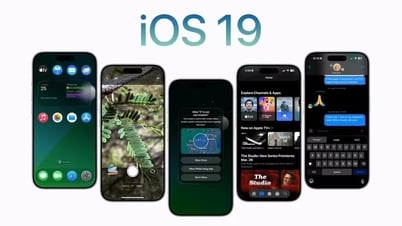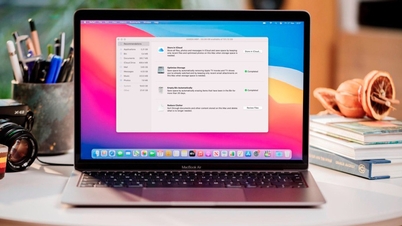Apple's services division has now 'bloated', becoming the company's second-largest revenue generator, behind only the iPhone.
In its third-quarter earnings report, Apple said service revenue reached $24.97 billion, an all-time high, up 12% year-over-year.
Chief Financial Officer Luca Maestri called it a “significant milestone.” “Looking back just a few years ago, the growth was phenomenal.”
Apple first reported its services revenue in the fourth quarter of 2014. At that time, the division brought in $4.8 billion.
Over the past decade, Apple’s services division has been a key driver of investor interest, with its profit margin of 74% in the most recent quarter, well above the company’s overall margin of 46.2%.

According to a filing with the US Securities and Exchange Commission (SEC), the division includes advertising, search licensing revenue from Google, AppleCare warranty fees, paid services such as iCloud, Apple TV+, payments from Apple Pay and AppleCare.
During a January 2016 earnings call, Apple CEO Tim Cook told investors to pay attention to the services division, which was still in its infancy.
“I do think the assets that we own in this space are very broad and probably something that the investment community wants and should focus on more,” he said.
Over time, Apple has compared its services division to the size of Fortune 500 companies – a list of the top 500 US businesses by revenue – to emphasize its scale.
According to CNBC , separating the service segment of "apple" is enough to rank 40th on the list, higher than Morgan Stanley bank and Johnson & Johnson company.
For investors, the service is attractive because many subscribers automatically sign up for recurring subscriptions. The model is more reliable than hardware because sales rise and fall based on demand with each iPhone generation.
Apple is confident that its services revenue will grow along with its stable user base. Once someone buys an iPhone, they are more likely to sign up for a subscription, use Safari to search Google, or buy a warranty.
The iPhone maker bundles its “subscription” figures to include both homegrown services like Apple TV+ and subscribers who buy apps on the App Store.
In February, the company revealed it had 2.2 billion active devices, and in August, paid subscribers hit 1 billion.
Still, Apple faces questions about how long its services business can continue to grow at such a rapid pace. From 2016 to 2021, the division recorded exceptionally high growth of about 27.3%.
Regarding the third quarter business results, Apple achieved revenue of 94.93 billion USD, earning 46.22 billion USD from iPhone, 7.74 billion USD from Mac, 6.95 billion USD from iPad, 9.04 billion USD from other products (including AirPods, HomePod, Apple Watch).
In the last quarter, Apple had to pay $10.2 billion in income taxes to settle a lawsuit from 2016 related to tax filings in Ireland, leading to a decrease in net income despite an increase in revenue.
The US technology giant currently holds $156.56 billion in cash.
The iPhone remains Apple’s most important product, accounting for 49% of its revenue. According to CEO Tim Cook, iPhone 15 sales “were stronger than iPhone 14 sales in the same period, and 16 sales were stronger than 15.”
He said he is pinning his hopes on Apple Intelligence, the AI feature set on iPhone and Mac that was just officially launched with iOS 18.1.
The head of "apple" revealed that the rate of users updating iOS 18.1 is twice as fast as 17.1 a year ago.
Apple capped off a busy week of earnings for the tech industry, with Alphabet reporting better-than-expected results on October 29, helped by growth in the cloud.
The next day, Microsoft issued disappointing revenue guidance for next quarter, leading to the biggest stock sell-off in two years, while Meta also warned that infrastructure costs would continue to rise sharply next year.
Amazon reports bullish growth in cloud segment.
(According to CNBC, Bloomberg)
Source: https://vietnamnet.vn/apple-tim-duoc-ga-de-trung-vang-thu-hai-sau-iphone-2337729.html



![[Photo] A delegation of 100 journalists from the Vietnam Journalists Association visits the soldiers and people of Truong Sa island district.](https://vphoto.vietnam.vn/thumb/1200x675/vietnam/resource/IMAGE/2025/5/30/0984a986227d4e988177f560d2e1563e)
![[Photo] National Conference "100 years of Vietnamese Revolutionary Press accompanying the glorious cause of the Party and the nation"](https://vphoto.vietnam.vn/thumb/1200x675/vietnam/resource/IMAGE/2025/5/30/1cf6cd5c8a934ebfa347028dcb08358c)

![[Photo] Journalists moved to tears at the Memorial Service for the soldiers who died in Gac Ma](https://vphoto.vietnam.vn/thumb/1200x675/vietnam/resource/IMAGE/2025/5/30/9454613a55c54c16bf8c0efa51883456)
![[Photo] General Secretary To Lam receives Chief of the Central Office of the Lao People's Revolutionary Party](https://vphoto.vietnam.vn/thumb/1200x675/vietnam/resource/IMAGE/2025/5/30/140435f4b39d4599a3d17975dfb444c5)





























































































Comment (0)